The Ventral Hernia Treatment Market is estimated to be valued at USD 5.7 billion in 2025 and is projected to reach USD 10.6 billion by 2035, registering a compound annual growth rate (CAGR) of 6.4% over the forecast period.
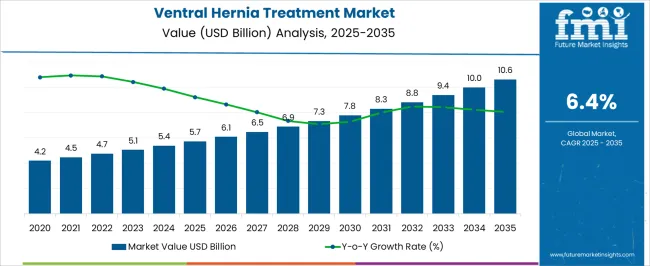
| Metric | Value |
|---|---|
| Ventral Hernia Treatment Market Estimated Value in (2025 E) | USD 5.7 billion |
| Ventral Hernia Treatment Market Forecast Value in (2035 F) | USD 10.6 billion |
| Forecast CAGR (2025 to 2035) | 6.4% |
The ventral hernia treatment market is experiencing steady growth driven by rising incidences of abdominal wall defects, an increasing aging population, and lifestyle factors contributing to hernia formation. Enhanced awareness about early diagnosis and treatment outcomes has encouraged timely medical interventions.
Technological advancements in imaging modalities and surgical procedures are supporting more accurate detection and minimally invasive treatment options. Hospitals and specialized surgical centers are investing in advanced diagnostic equipment and modern surgical tools to improve patient outcomes and reduce recovery time.
The demand for personalized treatment approaches is also shaping innovations in hernia repair techniques and materials. With growing healthcare infrastructure investments and an emphasis on improving patient safety and surgical efficiency, the market outlook remains positive, highlighting consistent opportunities for innovation and adoption across both diagnostic and surgical solutions.
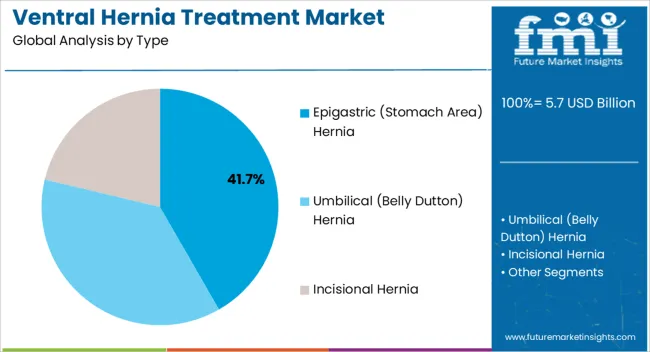
The epigastric hernia segment is projected to account for 41.70% of total market revenue by 2025 within the type category, making it the leading segment. This growth is being driven by higher prevalence of hernias in the stomach area due to factors such as obesity, physical strain, and genetic predisposition.
The segment has gained prominence as patients increasingly seek treatment for symptomatic cases that impact quality of life. Improved surgical techniques and the availability of mesh implants tailored for epigastric hernia repair have also contributed to better treatment outcomes.
As awareness of potential complications from untreated hernias grows, diagnosis and treatment rates continue to increase, strengthening the leadership of this segment in the overall market.
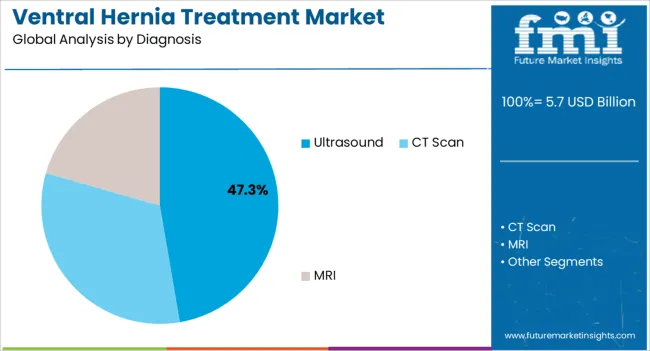
The ultrasound diagnosis segment is expected to capture 47.30% of the total market revenue by 2025, positioning it as the most widely used diagnostic approach. Its non invasive nature, real time imaging capabilities, and high accessibility in clinical settings have enhanced its adoption.
Ultrasound provides accurate visualization of abdominal wall defects without exposing patients to radiation, making it suitable for both initial diagnosis and post treatment follow up. The affordability and portability of ultrasound devices have supported widespread use across hospitals, outpatient centers, and smaller clinics.
As diagnostic protocols prioritize safety and efficiency, ultrasound has become the standard tool for ventral hernia detection, establishing its dominance in the diagnosis category.
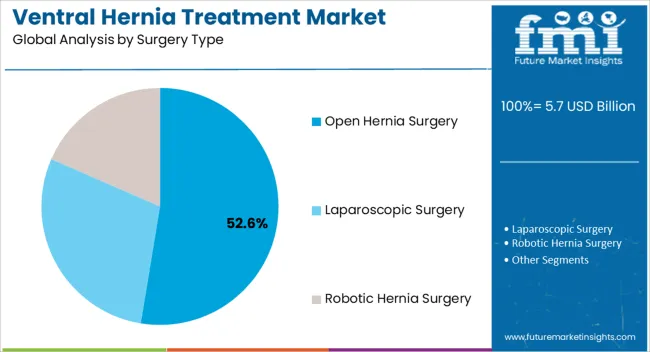
The open hernia surgery segment is anticipated to hold 52.60% of the total market revenue by 2025 under the surgery type category, reflecting its continued prominence. This dominance is attributed to its proven clinical outcomes, wide availability of trained surgeons, and applicability across a range of hernia complexities.
Open surgery techniques have been refined with the integration of advanced mesh materials and suturing technologies, leading to reduced recurrence rates and improved patient safety. While minimally invasive approaches are gaining traction, open surgery remains the preferred choice in cases involving large or complicated hernias.
The cost effectiveness of open procedures and their suitability for resource limited healthcare settings have further reinforced their widespread adoption, ensuring their leadership position within the surgery type segment.
According to market research and competitive intelligence provider Future Market Insights- the market for Ventral hernia treatment reflected a value of 3.3% during the historical period, 2020 to 2025.
The growth was attributed to the increasing prevalence of ventral hernias, the rising demand for minimally invasive surgical procedures, and the availability of advanced hernia repair devices. Moreover, key players have been investing in research and development for innovating novel therapies for ventral hernia treatment. Thus, the market for ventral hernia treatment is expected to register a CAGR of 6.4% in the forecast period 2025 to 2035.
Growing preference for minimally invasive surgical procedures driving market growth
The prevalence of ventral hernias is increasing globally due to several factors such as obesity, aging population, and sedentary lifestyle. This has led to a rise in demand for hernia repair surgeries and related products and services.
The development of advanced hernia repair devices such as mesh implants, surgical staplers, and robotic-assisted surgical systems has improved the efficiency and safety of hernia repair surgeries, leading to increased adoption of these devices.
Minimally invasive surgical procedures, such as laparoscopic surgery, offer several advantages over traditional open surgeries, including reduced pain, faster recovery, and shorter hospital stays. This has led to a growing preference for minimally invasive procedures among patients and healthcare providers.
Awareness and education campaigns by healthcare organizations and governments have helped to increase public awareness about ventral hernias and their treatment options, leading to increased demand for hernia repair surgeries and related products and services.
The increasing healthcare spending globally, particularly in emerging markets, has led to increased access to healthcare services, including hernia repair surgeries and related products and services.
Availability of treatments shaping landscape for ventral hernias treatment market
High cost of treatment along with reimbursement issues derailing market growth for ventral hernia treatment market
The cost of hernia repair surgeries and related products and services can be high, particularly for uninsured or underinsured patients, which can limit access to care. In some countries, reimbursement policies for hernia repair surgeries may be inadequate, which can limit access to care and affect the demand for hernia repair devices and related products and services.
Despite efforts to increase awareness about hernias and their treatment options, many people may still be unaware of the condition, which can delay diagnosis and treatment. Like any surgical procedure, hernia repair surgeries carry risks of complications such as infection, bleeding, and nerve damage.
The ventral hernia treatment market is highly competitive, with several key players operating in the industry, which can make it difficult for new entrants to establish themselves and compete with established players. The ventral hernia treatment market is subject to various regulations and standards, which can affect the development and commercialization of hernia repair devices and related products and services.
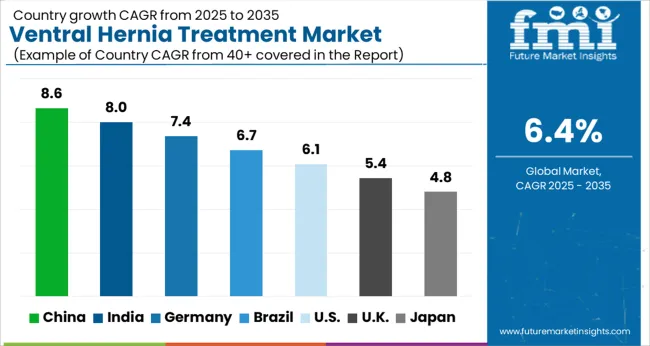
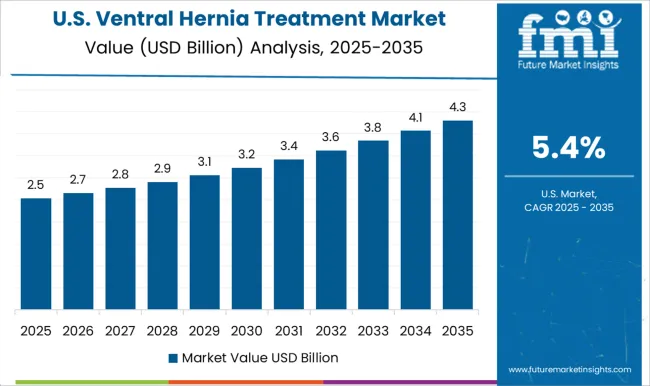
Growing preference for minimally invasive surgeries driving market growth in North America
The North American ventral hernia treatment market is a significant market segment within the global hernia treatment market. North America is one of the largest markets for hernia treatment globally, and it includes the United States and Canada.
The increasing prevalence of obesity and an aging population in North America has contributed to the rising incidence of ventral hernias in the region. This, in turn, has led to an increase in demand for hernia repair surgeries and related products and services.
The North America ventral hernia treatment market is highly competitive, with several key players operating in the industry. These companies are investing heavily in research and development to develop advanced hernia repair devices and surgical techniques.
The market is also witnessing a growing preference for minimally invasive surgical procedures, such as laparoscopic surgery, over traditional open surgeries. This trend is driven by the benefits of minimally invasive procedures, including reduced pain, faster recovery, and shorter hospital stays.
Overall, the North America ventral hernia treatment market is expected to continue to grow in the coming years, driven by increasing awareness and education about hernias, advances in hernia repair devices and surgical techniques, and the rising incidence of ventral hernias in the region. Thus, North America is expected to possess a 46% market share for ventral hernia treatment market.
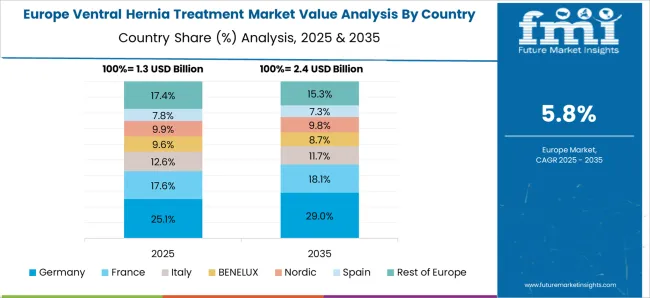
Rising demand for outpatient procedures bolstering growth of ventral hernia treatment market in Europe
The incidence of ventral hernias is increasing in Europe due to factors such as an aging population, sedentary lifestyles, and obesity. This has led to an increase in demand for hernia repair surgeries and related products and services.
The development of new and innovative hernia repair devices and surgical techniques is driving growth in the Europe ventral hernia treatment market. For example, the use of minimally invasive laparoscopic surgery techniques is increasing in popularity, as it is associated with faster recovery times and reduced pain compared to traditional open surgery.
There is a growing trend towards outpatient hernia repair surgeries in Europe. Outpatient surgeries are less expensive and more convenient for patients, which is driving growth in the ventral hernia treatment market. Many countries in Europe have favorable reimbursement policies for hernia repair surgeries, which is helping to drive growth in the ventral hernia treatment market.
There is growing awareness and education about hernias and their treatment options among healthcare providers and the general public in Europe, which is driving demand for hernia repair products and services. Thus, Europe is expected to possess a 38% market share for ventral hernia treatment market.
Availability of specialized medical staff maximizing the use of hospitals for ventral hernia treatment
Hospitals have a team of specialized medical staff, including surgeons, anesthesiologists, and nurses, who are trained and experienced in treating ventral hernias. These healthcare professionals have the necessary skills and knowledge to provide effective hernia treatment and manage any complications that may arise during or after the procedure.
Hospitals are equipped with advanced technology and equipment that are necessary for performing hernia surgeries safely and effectively. This includes surgical instruments, imaging technology, and monitoring devices that help ensure the patient's safety and well-being during the procedure.
After hernia surgery, patients require ongoing care and monitoring to ensure proper healing and prevent complications. Hospitals provide a range of post-operative care services, including pain management, wound care, and physical therapy, that can help patients recover more quickly and with fewer complications.
In rare cases, hernia surgery can lead to complications that require emergency medical attention. Hospitals are equipped to handle emergencies and have the necessary resources to provide life-saving care if needed. Thus, hospitals are expected to possess a 48% market share for ventral hernia treatment market.
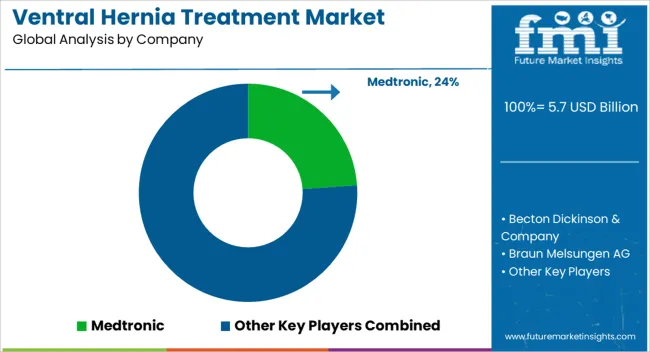
Key players in the ventral hernia treatment market are Medtronic, Becton Dickinson & Company, Braun Melsungen AG, Cook Medical Inc., Cooper Companies Inc., Baxter International, Inc., Integra LifeSciences, W.L. Gore & Associates, AbbVie, Johnson & Johnson Services, Inc.
| Report Attribute | Details |
|---|---|
| Market Value in 2025 | USD 5.7 billion |
| Market Value in 2035 | USD 10.6 billion |
| Growth Rate | CAGR of 6.4% from 2025 to 2035 |
| Base Year for Estimation | 2025 |
| Historical Data | 2020 to 2025 |
| Forecast Period | 2025 to 2035 |
| Quantitative Units | Revenue in USD Billion and CAGR from 2025 to 2035 |
| Report Coverage | Revenue Forecast, Volume Forecast, Company Ranking, Competitive Landscape, Growth Factors, Trends and Pricing Analysis |
| Segments Covered | Type, Diagnosis, Surgery Type, End Use, Region |
| Regions Covered | North America; Latin America; Europe; South Asia; East Asia; Oceania; Middle East & Africa |
| Key Countries Profiled | USA, Canada, Brazil, Mexico, Germany, United kingdom, France, Spain, Italy, India, Malaysia, Singapore, Thailand, China, Japan, South Korea, Austria, New Zealand, GCC countries, South Africa, Israel |
| Key Companies Profiled | Medtronic; Becton Dickinson & Company; Braun Melsungen AG; Cook Medical Inc.; Cooper Companies Inc.; Baxter International, Inc.; Integra LifeSciences; W.L. Gore & Associates; AbbVie; Johnson & Johnson Services, Inc. |
| Customization | Available Upon Request |
The global ventral hernia treatment market is estimated to be valued at USD 5.7 billion in 2025.
The market size for the ventral hernia treatment market is projected to reach USD 10.6 billion by 2035.
The ventral hernia treatment market is expected to grow at a 6.4% CAGR between 2025 and 2035.
The key product types in ventral hernia treatment market are epigastric (stomach area) hernia, umbilical (belly dutton) hernia and incisional hernia.
In terms of diagnosis, ultrasound segment to command 47.3% share in the ventral hernia treatment market in 2025.






Our Research Products

The "Full Research Suite" delivers actionable market intel, deep dives on markets or technologies, so clients act faster, cut risk, and unlock growth.

The Leaderboard benchmarks and ranks top vendors, classifying them as Established Leaders, Leading Challengers, or Disruptors & Challengers.

Locates where complements amplify value and substitutes erode it, forecasting net impact by horizon

We deliver granular, decision-grade intel: market sizing, 5-year forecasts, pricing, adoption, usage, revenue, and operational KPIs—plus competitor tracking, regulation, and value chains—across 60 countries broadly.

Spot the shifts before they hit your P&L. We track inflection points, adoption curves, pricing moves, and ecosystem plays to show where demand is heading, why it is changing, and what to do next across high-growth markets and disruptive tech

Real-time reads of user behavior. We track shifting priorities, perceptions of today’s and next-gen services, and provider experience, then pace how fast tech moves from trial to adoption, blending buyer, consumer, and channel inputs with social signals (#WhySwitch, #UX).

Partner with our analyst team to build a custom report designed around your business priorities. From analysing market trends to assessing competitors or crafting bespoke datasets, we tailor insights to your needs.
Supplier Intelligence
Discovery & Profiling
Capacity & Footprint
Performance & Risk
Compliance & Governance
Commercial Readiness
Who Supplies Whom
Scorecards & Shortlists
Playbooks & Docs
Category Intelligence
Definition & Scope
Demand & Use Cases
Cost Drivers
Market Structure
Supply Chain Map
Trade & Policy
Operating Norms
Deliverables
Buyer Intelligence
Account Basics
Spend & Scope
Procurement Model
Vendor Requirements
Terms & Policies
Entry Strategy
Pain Points & Triggers
Outputs
Pricing Analysis
Benchmarks
Trends
Should-Cost
Indexation
Landed Cost
Commercial Terms
Deliverables
Brand Analysis
Positioning & Value Prop
Share & Presence
Customer Evidence
Go-to-Market
Digital & Reputation
Compliance & Trust
KPIs & Gaps
Outputs
Full Research Suite comprises of:
Market outlook & trends analysis
Interviews & case studies
Strategic recommendations
Vendor profiles & capabilities analysis
5-year forecasts
8 regions and 60+ country-level data splits
Market segment data splits
12 months of continuous data updates
DELIVERED AS:
PDF EXCEL ONLINE
Hernia Protection Market Analysis - Size, Share, and Forecast Outlook 2025 to 2035
Treatment-Resistant Hypertension Management Market Size and Share Forecast Outlook 2025 to 2035
Treatment-Resistant Depression Treatment Market Size and Share Forecast Outlook 2025 to 2035
Hernia Mesh Devices Market Size and Share Forecast Outlook 2025 to 2035
Treatment Pumps Market Insights Growth & Demand Forecast 2025 to 2035
Hernia Repair Devices Market Insights - Trends & Forecast 2025 to 2035
Pretreatment Coatings Market Size and Share Forecast Outlook 2025 to 2035
Air Treatment Ozone Generator Market Size and Share Forecast Outlook 2025 to 2035
CNS Treatment and Therapy Market Insights - Trends & Growth Forecast 2025 to 2035
Seed Treatment Materials Market Size and Share Forecast Outlook 2025 to 2035
Acne Treatment Solutions Market Size and Share Forecast Outlook 2025 to 2035
Scar Treatment Market Overview - Growth & Demand Forecast 2025 to 2035
Soil Treatment Chemicals Market
Water Treatment System Market Size and Share Forecast Outlook 2025 to 2035
Water Treatment Chemical Market Size and Share Forecast Outlook 2025 to 2035
Algae Treatment Chemical Market Forecast and Outlook 2025 to 2035
Water Treatment Market Size and Share Forecast Outlook 2025 to 2035
Water Treatment Ozone Generator Market Size and Share Forecast Outlook 2025 to 2035
Water Treatment Equipment Market Size and Share Forecast Outlook 2025 to 2035
Burns Treatment Market Overview – Growth, Demand & Forecast 2025 to 2035

Thank you!
You will receive an email from our Business Development Manager. Please be sure to check your SPAM/JUNK folder too.
Chat With
MaRIA